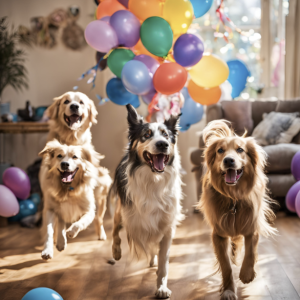31 Farty Party: Instructor guide
Samantha Corning; Regyn Jelle; and Macy Shaul
Farty Party

Instructional Guide
Students will explore how farts are made in the body in both dogs and cats, and how different dietary changes impact this process. The lesson includes a narrated story book, a matching activity, and a board game assessment.
Intended Grade Level
This lesson is intended for 3rd-5th grade students. Students should be familiar with general anatomy of the GI system, such as the stomach and intestines. Students should be aware of what dogs and cats typically eat.
Learning objectives
- Students will be able to explain what causes farts.
- Students will be able to explain common causes of farts in dogs.
- Students will be able to identify foods that increase farting in dogs.
- Students will be able to acknowledge differences in farting between cats and dogs.
Lesson Format
The following can be done in any size group (when group activities are specified). No materials are necessary as all activities are present online.
First students will read or listen to the story book “Mom, Why Do I Fart?” (5 minutes)
Next, students will match different foods to farting behavior in a matching game activity. This will be completed independently. The image of food should be matched to the correct farting behavior. If incorrect, the image will turn red. Students can continue fixing the item sorting until all images turn green, meaning they are in the correct place. (3 minutes)
Then, students will perform an assessment in the context of a board game. Students may work in small groups for this activity if they wish, or they can chose to work alone. (10 minutes)
Finally, students will engage in a discussion using prompted cards. Students will work in a small group. Each question should take 2-3 minutes to discuss. (15 minutes)
Lesson Background
Flatulence, or farting, is uncommonly heard in many pets and can often throw owners off guard. Farting is normal for many animals but there are things that can cause an abnormal increase in the frequency of farting. Changes in the diet of an animal can cause them to fart more than normal. This includes something such as switching them over to a new food too fast and not allowing their body adequate time to digest, or feeding them foods that their body cannot readily digest such as super fatty foods or dairy. The mechanism behind the creation of a fart lies behind the good bacteria within the intestinal tract of animals. The population of the bacteria grows as we make our way down the length of the intestines and here they’re responsible for breaking down food sent through in order to utilize as many nutrients as possible from the ingested food. Certain foods cause the bacteria to release more gas during breakdown thus leading to a release of more gas from the colon, causing animals to fart. These microbes like lots to eat, new stuff to eat, and lots of time to eat it, and when these bacteria get what they want, they will produce more gas. Indigestible food (such as dairy in dogs since they lack the enzyme lactase that breaks down the lactose in dairy) ends up in the colon with these microbes leading to a proliferation in gas production and therefore flatulence. However, farting does not just originate from the diet. Aerophagia, or an increase in swallowed air such as that that happens when an animal eats too fast or pants excessively, can also cause them to pass more gas. Excessive panting leads to an accumulation of air in the GI tract of dogs, but because cats do not pant as dogs do, you will not notice an increase in flatulence from accumulated air.
Common misconceptions and challenge points
Misconceptions:
- Farting only happens when you eat beans or foods that make you gassy.
- Farting is a normal part of digestion and can occur despite what you eat.
- Farts always smell bad.
- Farts don’t always smell bad, it can heavily depend on what you eat.
- Holding in a fart causes it to move upwards.
- Your fart does not travel back upwards. It will remain in the end of your GI tract, it may diffuse which is why you no longer feel like you have to fart.
Challenges:
- The fact that bacteria reside inside bodies.
- There is lots of bacteria that is healthy and good! Bacteria helps with normal functions and digestion.
- Certain foods make my dog fart, but why don’t they make me fart?
- You more commonly eat those foods! For example, humans eat cheese or dairy products almost daily, dogs typically only eat kibble each day.
Assessment
Students will travel through the board game map, answering questions about farts in order to continue. As students get questions correct, they travel further along the map. This will assess whether they meet all 4 learning objectives above.
Further exploration
Additional resources are provided on the student page.
Other chapters within this textbook may be interesting for students. Some options can be found linked below:

